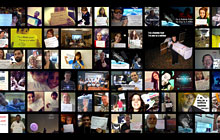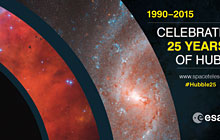Editorial
There are exciting times ahead as we ramp up the organisation of worldwide events that will celebrate, on 24 April 2015, the 25th anniversary of the Hubble Space Telescope’s launch.
Our "old" telescope is still super busy observing the Universe, and producing amazing results. This year we had a particularly productive year, with a huge number of interesting news stories, especially from European astronomers. Please remember that we are always interested to hear about your new Hubble results, and we are happy to help you publicise them. Just drop an email to our press officer Georgia on gbladon@partner.eso.org.
Touching wood, the observatory is in excellent health. We observe the occasional glitch with the scientific instrument computer — the SI Command and Data Handling (SIC&DH) unit — which sometimes locks up, halting science operations. However, these events are totally known and benign, and usually the telescope resumes science observations in a few hours.
With 25 years of operations under the belt, a perfectly appropriate question to ask is: "what is Hubble's expected lifetime?" So, we have asked the experts.
In 2013, the NASA Engineering and Safety Center (NESC) re-examined the assumptions being used in determining the probable lifetimes of all Hubble’s subsystems. Their formal analysis shows that there is a > 98% probability of having Wide Field Camera 3 (WFC3) and the Cosmic Origins Spectrograph (COS) available in 2020. Their analysis also shows that there is > 82% probability of having at least two Fine Guidance Sensors (FGS) for pointing available at the time of the JWST launch, and a probability > 95% of having at least one operational gyro in 2020. Other critical subsystem reliabilities are all > 85% out to 2020, indicating that it is very realistic to expect the Hubble observatory to be scientifically viable and highly productive through to, at least, 2020.
This result inspired the name for next year’s STScI spring symposium: Hubble 2020: Building on 25 years of Discovery, and our plan to solicit your collective help in crafting the scientific legacy of this mission over the next five years. We hope to see you at this fun event, which will include a celebration of Hubble’s splendid 25 years in orbit!
Finally, now is the time for you all to start thinking of clever new ideas for ways to use Hubble. The Call for Proposal for Cycle 23 will go out in early January, with a proposal deadline of 10 April 2015. Our gratitude goes to those of you who have already accepted to be panel members, chairs, and at-large members in our Time Allocation process, which is at the foundation of Hubble’s excellent observing programme. We look forward to welcoming you to Baltimore in June!
Antonella Nota
ESA HST Project Scientist/STScI Baltimore
Email: HubbleNewsEurope@stsci.edu

|
3 December 2014: November marked a big step for our ESA/Hubble outreach as the ESA/Hubble Facebook page reached 1 million likes! This means that every press release we send out, every Hubblecast we make and every announcement or new initiative from ESA/Hubble, reaches over a million people before it even reaches a news editor's desk.
To celebrate this achievement ...
|
| Read more |

|
3 December 2014: On 20–23 April 2015 STScI will hold its spring symposium, with this year’s title being Hubble 2020: Building on 25 years of Discovery.
Typically, STScI holds a major scientific symposium every May, on a broad variety of topics that are of high relevance to the scientific community. In 2015, the symposium will be dedicated to the Hubble Space ...
|
| Read more |

|
3 December 2014: As the year draws to a close it is time to look ahead to 2015, the year that marks 25 years of Hubble.
The plans for celebration have already begun with a variety of public activities on the table and it is time to let you know about what ESA/Hubble has in store.
Ode to Hubble, is a public ...
|
| Read more |